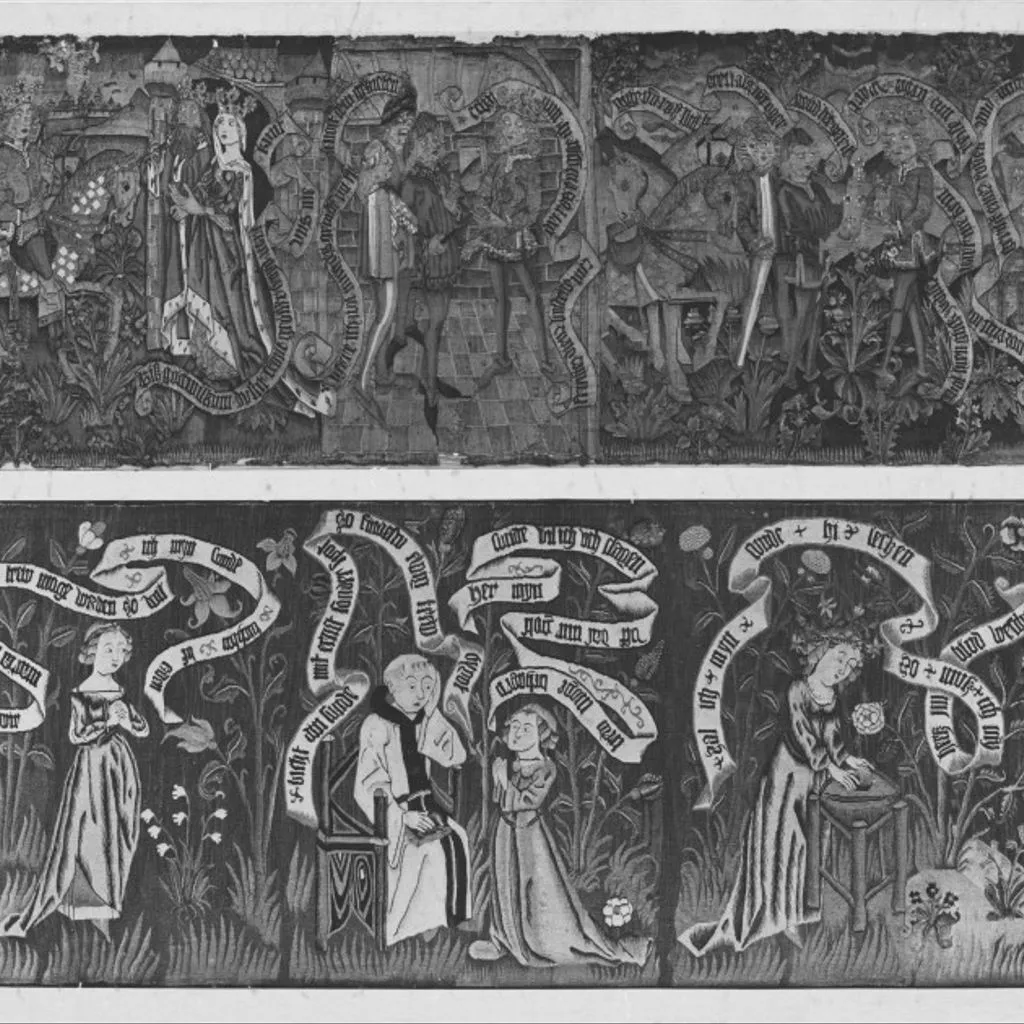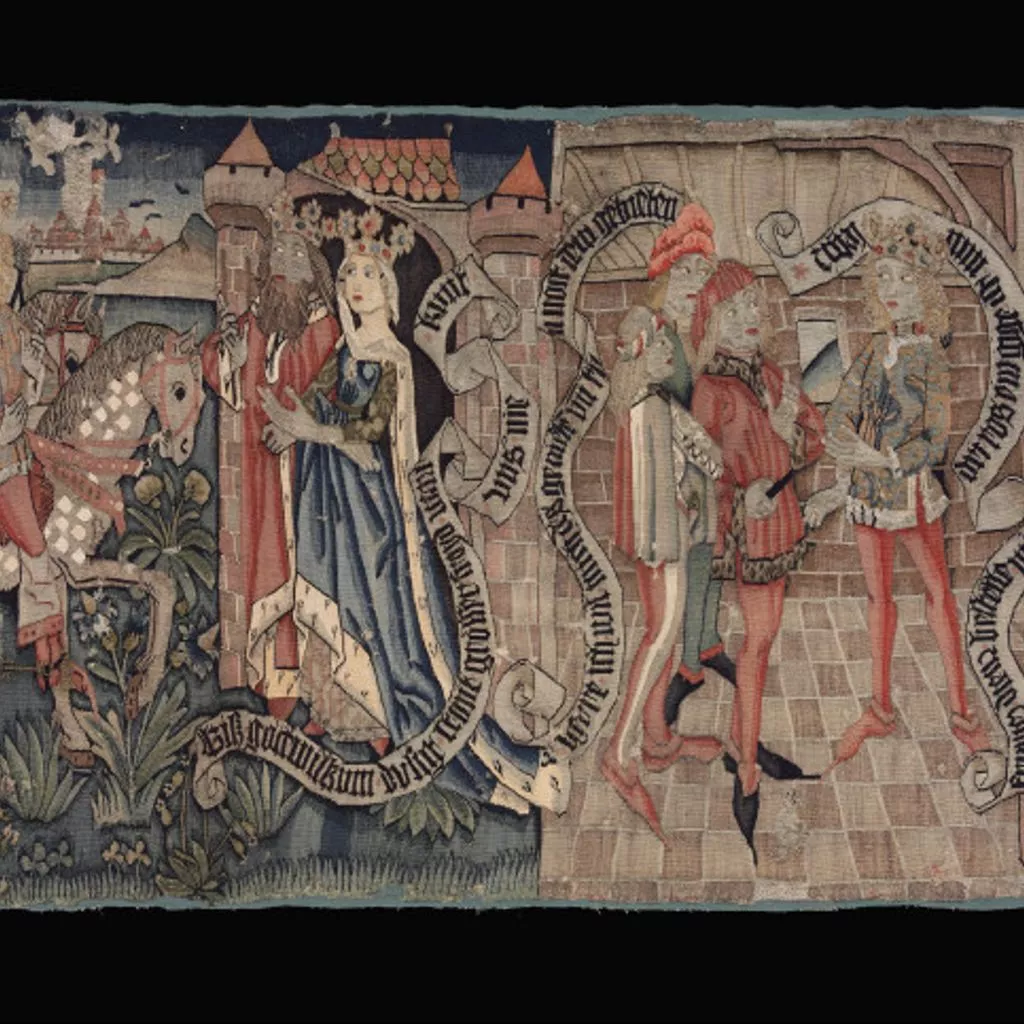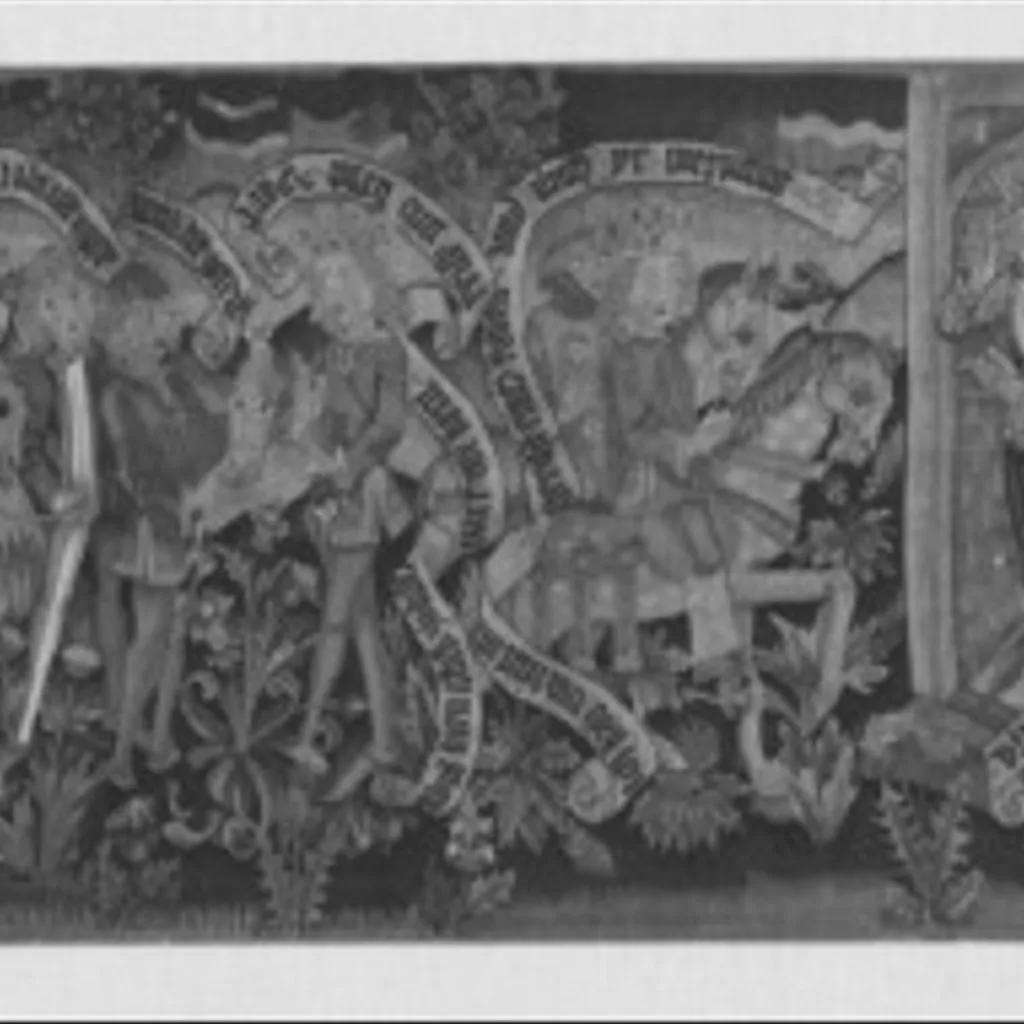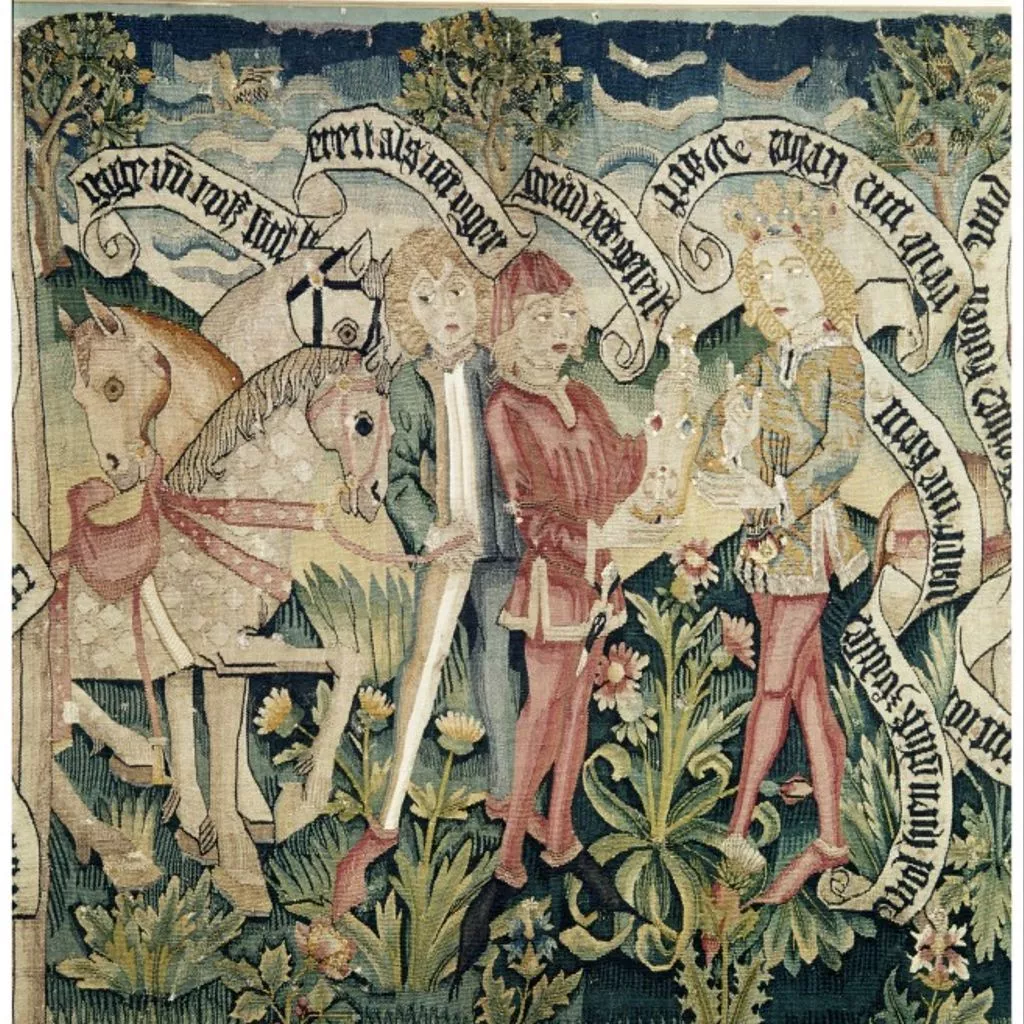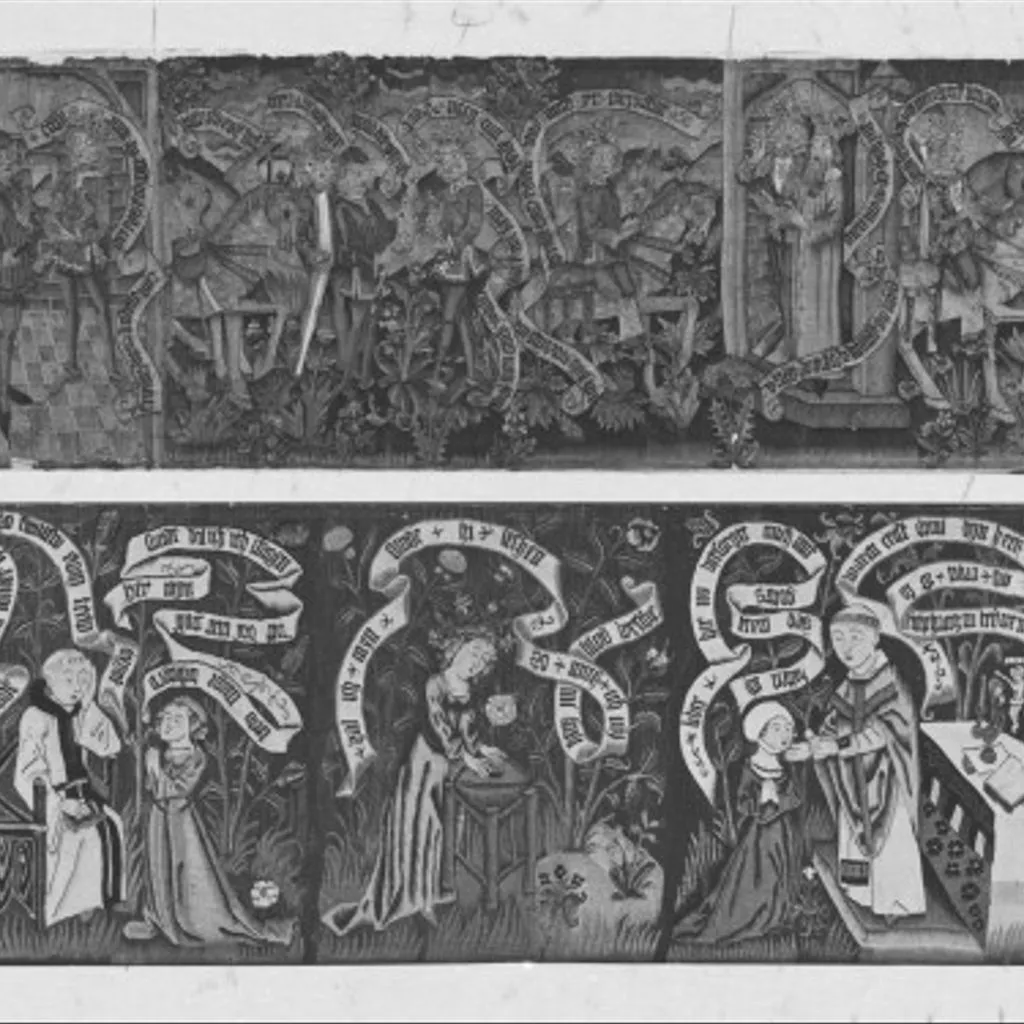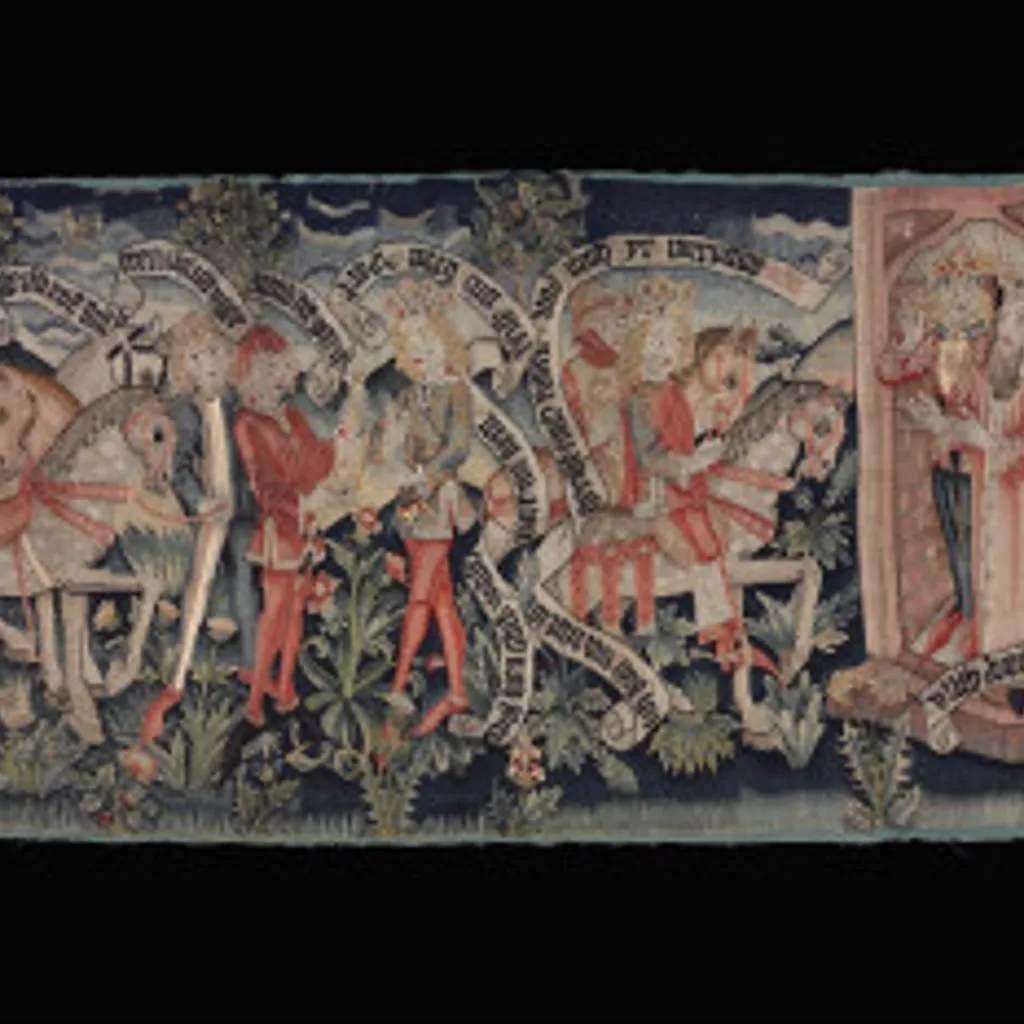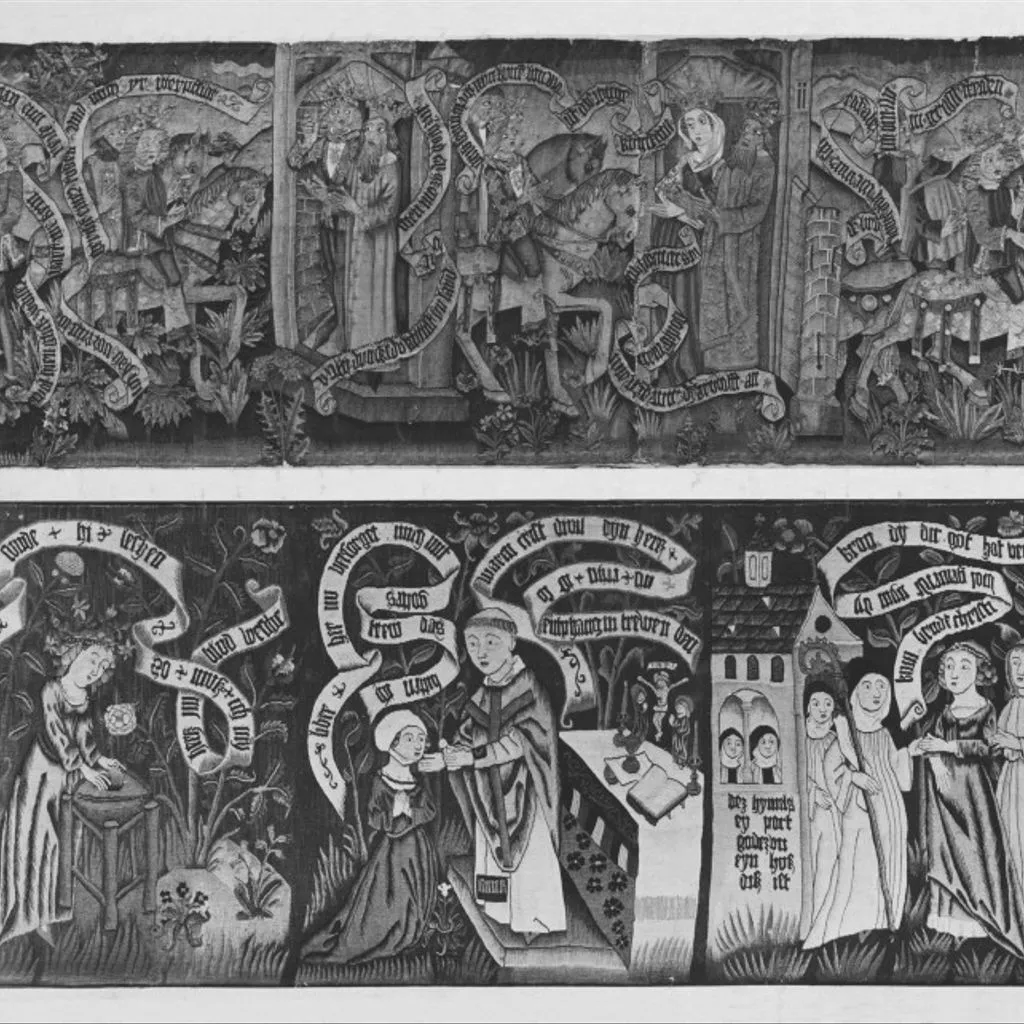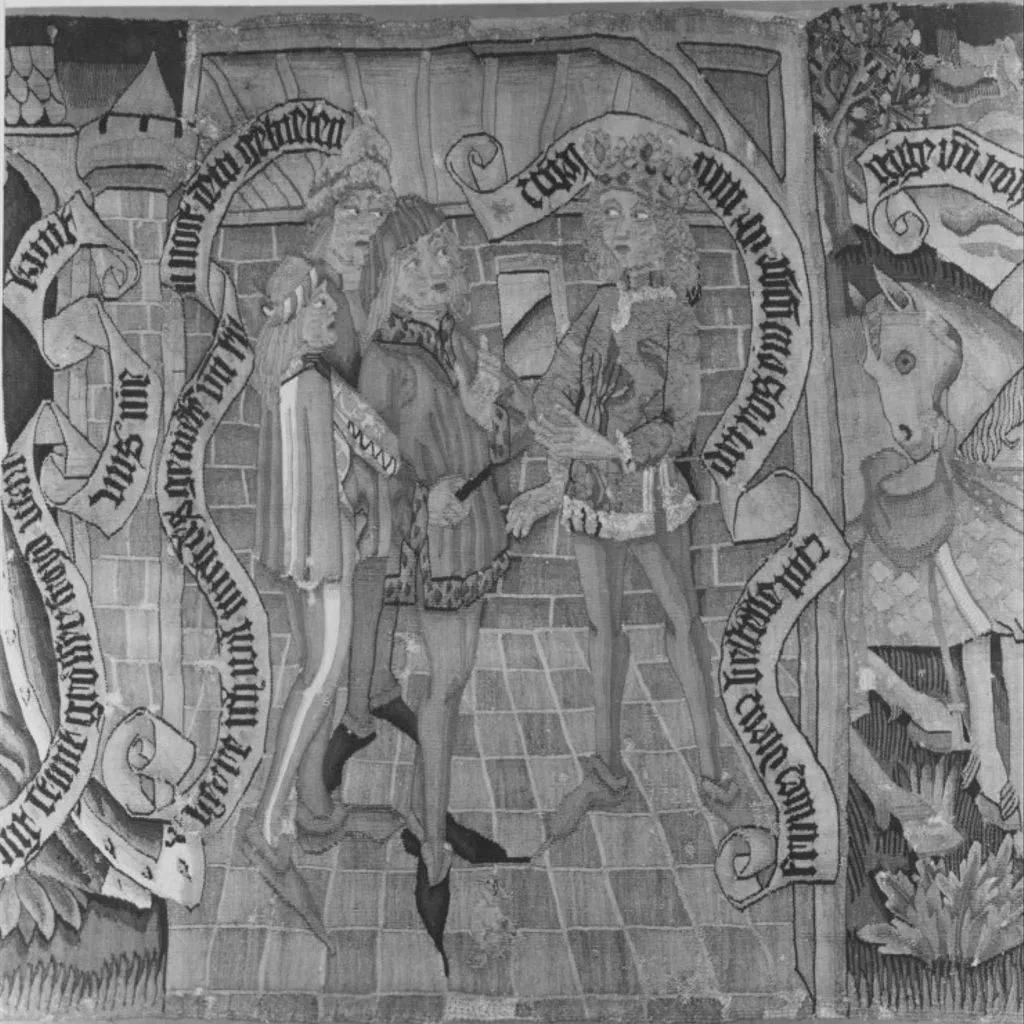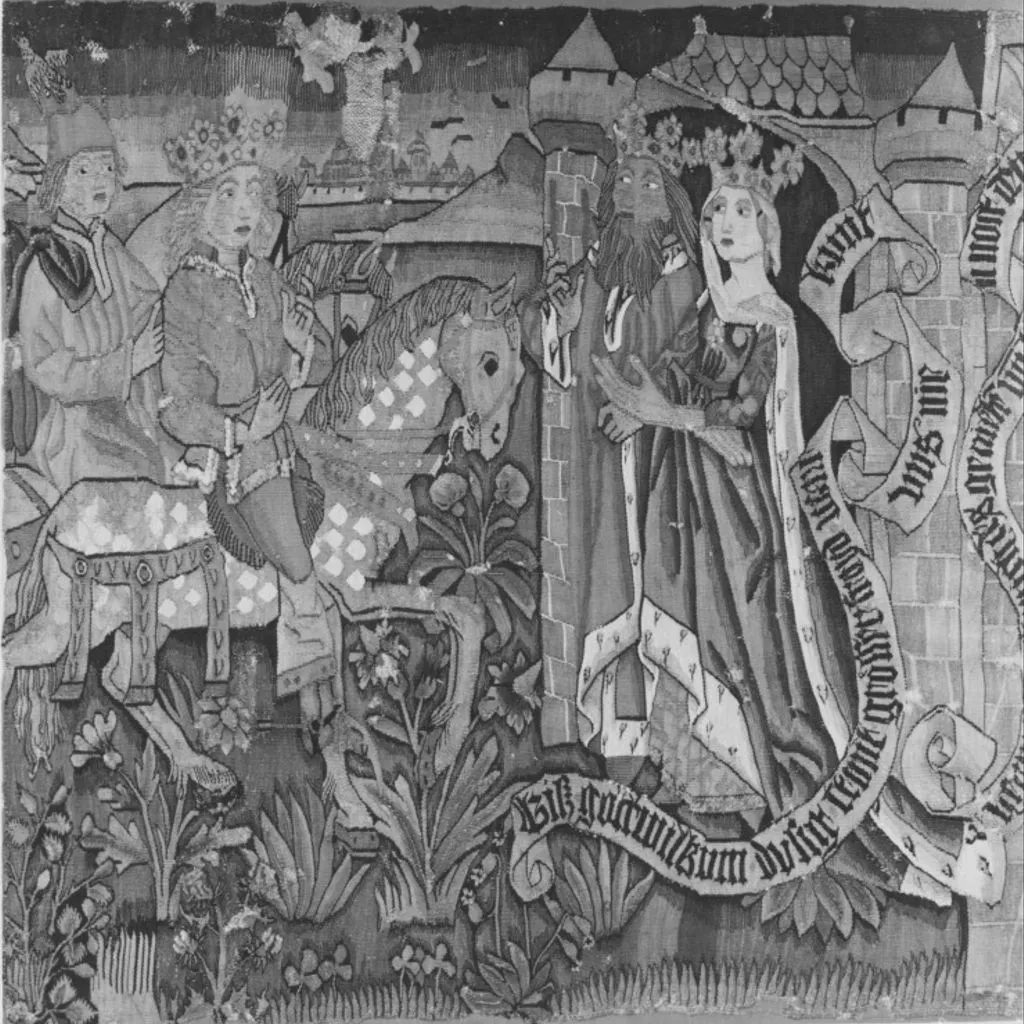Description
Der Busant tapestries belong to a group which derives from the Vienna hunting tapestry, which has two shields of arms, which are those of the Strasbourg families of Boecklin von Boecklinsau and of Mühlheim. There is no doubt that this whole group is of Alsatian origin, a fact further proved by the dialect of the inscriptions. Since the 15th century tapestries in Germany were very local in origin, it is likely that a tapestry containing Alsatian shields would have been made in Alsace. The design is Alsatian in character and may derive from book illustrations.
This tapestry is a Rücklakan, meaning a strip of textile placed above the seating area - long benches along the walls; this strip is long in comparison with other extant examples. There are other strips showing the same story in the Museum für angewandte Kunst, Cologne (68 cm long); the Germanisches Museum, Nüremburg (180 cm and 1985 cm long); the former Figdor Collection, Vienna; Musée de Cluny, Paris; the Burrell Collection, Glasgow (acquired by Sir William Burrell in 1938); and The Metropolitan Museum of Art, New York.
Production
A small group (53) of 15th- and early 16th-century tapestries made in Strasbourg have survived. At that time, Strasbourg produced tapestries as many tapestries as Flemish weavers, although they tended to be smaller in size and few have survived. Documents reveal that the majority of the commissions came from members of the social elite who were active in finance, politics, or the Church. It is not known precisely how many weavers were active in Strasbourg, but numerous workshops were at work in the 15th century throughout the region of the upper Rhine. Recent studies have revealed that most of them were full professional workshops rather than single independent patrician women or nuns working. Tapestries of this type were known as Heidnischwerk (non-Christian work), a name that was applied to tapestries showing both profane and religious subjects; it became a generic that referred to all tapestries made in Switzerland and Southern Germany. The origins of the name are not certain, but may refer to the place where tapestry weaving originated or to the expensive damasks or brocades which were frequently depicted in the background of these tapestries and were woven by non-Christian craftsmen.
The story
The oldest known manuscript of the story is from the 15th century, and is currently in the Bremer Stadtbibliothek. The Alsatian poem probably derives from the 13th centuy French romance L'Escoufle.
Rich in scenery and anecdote, this tapestry illustrates with cartoonlike immediacy part of the story of Der Busant (The Buzzard), and recounts the Alsatian love affair of an English Prince with a French Princess. It dates to the early fourteenth century. It is about love conquering all, elopement, and mistaken identities. Six scenes are shown on the V&A piece, seven others are preserved in strips elsewhere. The complete story is as follows: the Prince of England goes to school in Paris, and there meets the Princess of France. They fall in love despite her already being promised, against her will, to the King of Morocco. They plan that he shall return on her wedding day in Paris and abduct her. The Prince goes back to England, takes three horses and a fiddle and returns later to the French court disguised as a minstrel. When the French King proposes to hire him to perform during the ceremonies, he rejects the proposal on the basis that he has to free a white dove that he tied up a year before. The King of Morocco comes to claim his bride, but the lovers secretly meet in the garden and flee on horseback. They ride through the forest on the prince's horse, but exhausted they rest in a clearing with the Princess laying her head on his lap. During her sleep, the Prince removes two valuable rings from her finger and admires them. Suddenly a buzzard swoops down from the heavens and snatches the trinkets away. As he pursues the bird, trying in vain to hit it with sticks and stones, the Prince penetrates deeper and deeper into the forest and loses his way. After a frantic search for his beloved, whom he has left behind, he loses his mind. He tears off his fine clothes, the tokens of his humanity, and proceeds to roam the woods, beast-like, on all fours, as a wild man. The princess, meanwhile, much less perturbed than he, finds refuge in a mill, and survives by making beautiful ecclesiastical vestments. Her noble background is recognised by the brother of the English King, who brings her to castle Engelstein, where she remains another year. By chance hunters come upon a hairy wild man, whom they bring to the castle as a curiosity. The kindly duke, aware that the creature may not always have been wild, sees to it that he is treated with consideration and taught to walk upright. Recognition of the wild man's former identify and the reunion of the lovers is effected when the prince, upon being taken to the hunt, engages in the eccentricity of biting off the head of a buzzard. Asked what had brought on such strange behaviour, he explains that he hates buzzards beacuse, years ago, a buzzard had caused him to lose his beloved. He is then recognised by the Princess and they fall into each other's arms. Knights are sent out to inform the parents of the reunion, the wedding takes place with feasting and a tournament.
Complementary pieces
After these scenes on the V&A strip come those preserved in Cologne and Glasgow (the same two scenes in each place) :
1. the lovers asleep in the forest;
2. the buzzard, making off with the ring.
There is an apparent gap followed by the fragment in The Metropolitan Museum of Art (1985.358. Given by Murtogh D. Guinness), with three scenes showing:
1. the prince as a wild man on all fours;
2. the French princess rides forth on a horse, leaving the woods;
3. she seeks the help of the miller.
The five scenes in the Nuremberg strip are:
1. after the reunion of the lovers, news is sent out to their parents;
2. the marriage;
3. the marriage feast;
4. a tournament;
5. the lovers return to England mounted on one horse. These last two scenes are also found on the piece in Musée de Cluny.
Two fragments from the private collection of the Honourable Murtogh Guinness (who donated a piece to the Met) went on sale at Christies, London 13/11/2003. Lot 170 (83 cm x 58 cm) shows two scenes:
1. the flight of the Lovers on horseback, followed by their pages (scroll inscribed De brutiomer dut we uver scheide aber ich bin sin in grosser freiden) and
2. the Lovers resting and the Theft of the Ring, with the Prince chasing the buzzard (scroll inscribed Ach got du mit diner helffe... schin dz finerlin).
Lot 171 (115 cm x 310 cm) depicting
1. The Passing over of the Violin and Horses to the Prince (scroll inscribed wol gluk su diser vart nie kein rese mir liber wart);
2. The Arrival of the Prince at the French Court (scrolls inscribed mich dunckt du kumst vn land vit dien mir zu der hochzut and ich hab vor eim ior geriht einer tuben und mich yr werpfliht);
3. The Reception of the Morrocan Groom by the French Royal Couple (scroll inscribed umbsemlich ich nin kune bin wo ist die iunge kunigun and bis wilku lieb dochter man wie... e wir dz brulofft an).
Popularity of subject
Der Busant represents possibly the most prolifically woven subject in Strasbourg during this time. The height of the various pieces differs a little, minor differences in treatment, and divergent quality of execution (some very finely woven with great detail, others rather coarsely woven) indicate that they not only come from different sets but possibly also from different workshops. Also the cartoons used seems to have been 'modernised' for later weavings, for example the Nuremberg piece is probably from the second weaving of about 1490.
Long narrow tapestry band with a narrative scene. Split tapestry-woven wool, white linen, silk and gold thread, with cotton used in the faces and hands on linen warps, and with knotted pile for parts of the costume (jackets, hats, fur) and for the flowers; 7 warps per centimetre.
This long narrow band, or Rücklakan, for hanging behind a bench, tells the Story of the Buzzard (Der Busant), a Middle High German romance written in poetry in the early 14th century in Alsace. Six scenes are shown on this piece. The scenes are identified by inscriptions on decorative bands: The first scene has the return to England of the King's son; in the second, he asks his servants for three horses and a fiddle; the third with the horses brought and the Prince sets out; the fourth with the Prince welcomed at the court of the French King; the fifth with the King of Morocco coming for his bride; and the sixth with the Prince escaping with the Princess.
Rich in scenery and anecdote, this tapestry illustrates with cartoonlike immediacy part of the story of Der Busant (The Buzzard), a romance from Alsace. It recounts the love affair of an English prince with a French princess and dates from the early 14th century. This piece shows six scenes of the story, while seven other fragments depicting the same story are preserved in other European museum collections.
The Buzzard is unusually long and narrow in height for a tapestry, and would have been called Rücklakan in German. This term denoted a long strip of textile which was placed above the seating area, or covering the seat back. The tapestry production of Strasbourg was not far behind Flanders in quantity, yet fewer have survived to the present day - possibly becaue they were generally small in size. Documents reveal that the majority of the commissions came from members of the social elite who were active in finance, politics or the Church.
Tapestry Hanging. Legendary or romance subject, in five compartments. 15th centy. L. 12ft., W. 2ft. 6in. Bought, 10l. 4509-'58. [1858]
Tapestry, woven in linen, wool, silk, and metal thread, Strasbourg, 1480-1490; The Buzzard























